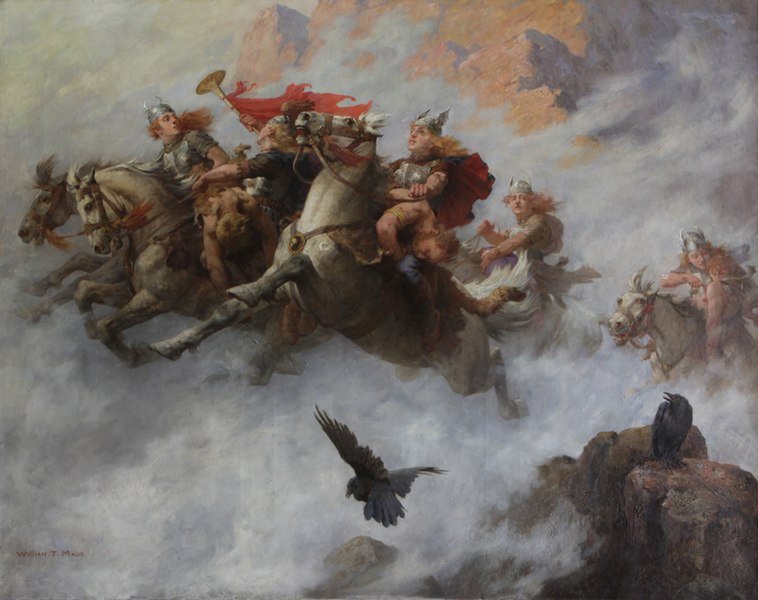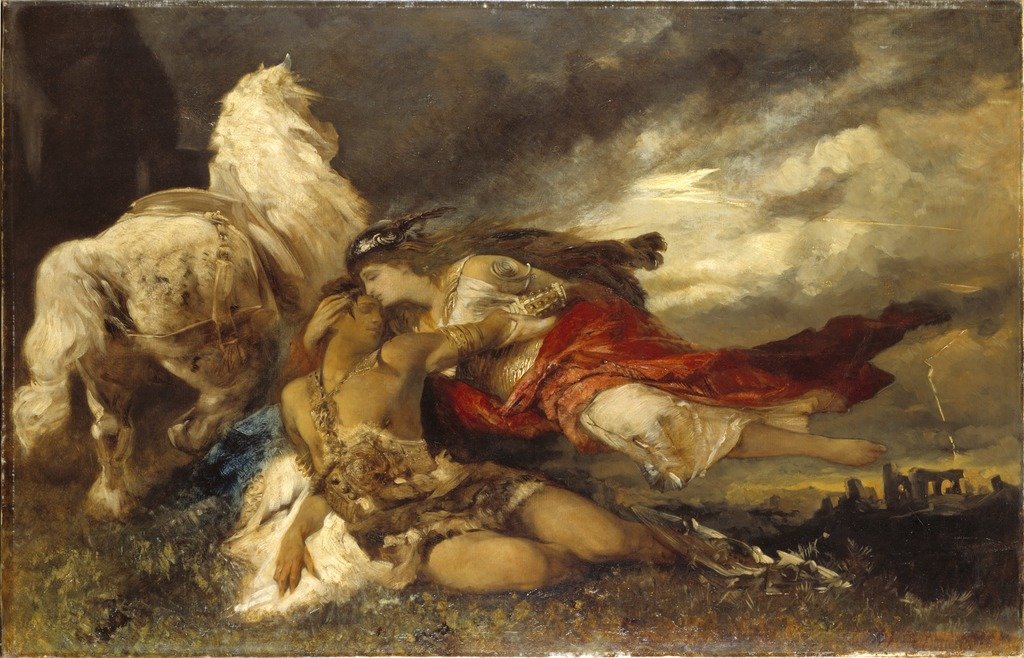In the enchanting realm of Norse mythology, the Valkyries, also known as the “choosers of the fallen,” reign as captivating and complex female helping spirits of the revered god Odin. The modern portrayal of these ethereal maidens focusing on their role in guiding fallen heroes to Valhalla is not entirely inaccurate. However, it does gloss over their more ominous qualities.

In ancient times, the Valkyries were far more sinister figures, wielding their powers to determine both life and death on the battlefield through malicious magic. Their name echoes their dual role, as they not only selected warriors for Valhalla but also decided who would meet their fate on the battlefield.
Similar beings of carnage existed among other Germanic and Celtic cultures, further solidifying the Valkyries’ place in the world of shamanism that pervaded pre-Christian Germanic religion. Like Odin’s loyal wolves, Geri and Freki, the Valkyries are intricately connected to the god, embodying facets of his being within their enigmatic existence.
What Exactly is a Valkyrie in Norse Mythology?
In Norse mythology, a Valkyrie is a fierce warrior woman riding a horse, wolf, or boar, armed with a spear. As the “chooser of the slain,” she determines the fate of warriors in battle and transports the fallen to Odin’s Valhalla. Those chosen by Valkyries will fight alongside Odin during Ragnarök.
Origins
Valkyries, powerful female helping spirits of Odin in Norse mythology, feature in various ancient texts, including the Prose Edda and Poetic Edda, as well as in Germanic works. These mythological tales were passed down orally until the region’s conversion to Christianity around 1000-1100, leading to written accounts by Christians or those influenced by Christianity.
The roots of the powerful warrior maidens with supernatural abilities can be traced back to the Germanic tribes, who later migrated northward and established themselves in Scandinavia. Alongside this, the association with swans can be linked to ancient pagan beliefs among the Germanic tribes. An interesting parallel can be found in The Three Swans, a German folktale, which bears a striking resemblance to Volundarkvitha within The Poetic Edda.

Originally, Valkyries may have been perceived as death demons, guiding souls to an afterlife. The concept of Valhalla, a hall of heroes, developed later, influencing the transformation of Valkyries into gleaming figures embodying both beauty and martial prowess.
Throughout the Viking Age (c. 790 – c. 1100), the image of Valkyries might have evolved under the influence of shieldmaidens, women who fought alongside men. Debate continues on the historical existence of such warrior women, but their presence in legends and myths is undeniable. Iconic Valkyrie figures include the goddess Freyja, shieldmaiden Lagertha, heroic Hervor, and the formidable Brynhild, who challenged Odin’s will.
The Valkyrie image could have been inspired by Celtic heroines like The Morrigan or Queen Maeve, given the established trade relations between Celts and Scandinavians. Additionally, Norse women in the Viking Age were known to possess warrior capabilities, adding to the enigmatic allure of the Valkyries of Norse mythology.
Famous Valkyries In Norse Mythology
Hildr: In the ancient tale of Hjaðningavíg, the legend of Heoinn and Hogni unfolds, and within its epic narrative emerges the intriguing figure of Hildr, daughter of Högni and Hervor. Kidnapped by Prince Heðinn, Hildr’s fate becomes entwined with the destiny of her father, igniting a fierce battle known as Hjadning’s Strife.

In a desperate attempt at reconciliation, Hildr gifts her father a precious necklace from Heðinn. Yet, reconciliation eludes them, and the kings engage in an epic battle that lasts through the day. As the sun sets, the warriors retreat to their ships, but the night brings an astonishing twist—Hildr emerges on the battlefield and performs a miraculous act. With her mystical powers, she revives the fallen, transforming the battlefield into a place of eternal strife.
Day after day, the kings clash, and the fallen are resurrected, trapped in an unending cycle of combat. Each warrior, their weapons, and shields turn to stone at day’s end, only to be renewed with the dawn. This immortal struggle, marked by stone warriors and relentless clashes, is foretold to endure until the prophesied time of Ragnarök—the cataclysmic event that will bring about the end of the world.
Brynhild is a complex and multi-faceted character, who navigated the realms of gods and mortals with grace and determination. A figure of both beauty and strength in Viking legend, Brynhild is one of the most famous Valkyries in Norse mythology. Brynhild held a crucial role in Odin’s Great Hall of Valhalla, where brave fallen warriors were welcomed and honored.
Unlike the gentle harp-playing depictions of some Valkyries, Brynhild donned armor and wielded her weapons with grace, embodying the essence of a powerful and wise female spirit.
One fateful day, she was tasked with deciding the winner of a battle in the land of humans, Brynhild’s choice differed from Odin’s preference. Therefore, she was punished to endure the existencfe of a mortal woman and cast down to Midgard. Her paths crossed with that of Sigurd the dragon Slayer, beginning a tragic tale of love that eventually ended with dead of Sigurd, leading Brynhild to take her own life.
In Viking lore, the daughter of Brynhild and Sigurd is Aslaug, who would go on to marry the legendary Viking Ragnar Lothbrok, intertwining Brynhild’s lineage with other prominent figures in Norse sagas.
Gondul (wand-wielder) is a prominent figure in Norse mythology, appearing in various sources like Heimskringla, Sörla þáttr, a 14th-century Norwegian charm, and the revered Poetic Edda and Prose Edda.
Gondul’s encounters with Prince Heoinn are particularly noteworthy. On three occasions, she crossed paths with him, shaping his destiny with her divine counsel. First, she urged him to embark on a daring journey to the north, testing his strength against Hogni. Later, she inspired him to carry out the kidnapping of Princess Hildr.
However, it was their final encounter that truly unveiled Gondul’s enigmatic nature. Revealing her connection to Odin, she disclosed that Heoinn and his entire army were ensnared in a spell, orchestrated by Odin the Allfather himself. Bound to fight relentlessly until the fateful event of Ragnarok.
Norse Goddesses Associated with Valkyries
In Norse mythology, all1 Valkyries are not just faceless figures, but distinct and powerful goddesses with unique roles. Eir, known as “mercy,” protects and heals the living during battles, showing compassion to the wounded. Thrud embodies both a formidable warrior and a caring caretaker of the fallen warriors in Valhalla. Some sources even suggest that she might be both a goddess of battle and a Valkyrie.
Sigrún, also known as Sváva, plays a significant role in transforming heroes like Helgi, granting them their names and the gift of speech. The Helgi poems highlight the transformative influence of the Valkyries.
Additionally, Freyja, often considered a possible model for the Valkyries, arrives at the battlefield to choose heroes for her own hall, Sessrúmnir, in Fólkvangr. She takes half of the fallen warriors for herself, while the other half is chosen by the Valkyries to join Odin in Valhalla.
What did Valkyries Symbolize in Norse Culture?
In Norse mythology, Valkyries held a profound significance, symbolizing a glorious death in battle as a means to earn entry into Valhalla. The imagery surrounding Valkyries exuded power, prestige, and heroism, reflected in their names and the stories they feature in. In Norse mythology, the numbers three and nine were laden with symbolism, representing prophecy and divinity. Valkyries were often grouped in threes and nines, adding to their mystical allure.
As Norse paganism underwent a gradual conversion, Christian elements merged with the Valkyrie symbolism, viewing them as aids in the world’s rebirth. The warriors chosen by the Valkyries, as well as the Valkyries themselves, played crucial roles in the impending Twilight of the Gods. This amalgamation of themes enriched the complex tapestry of Norse mythology, cementing the Valkyries’ enduring significance in tales of heroism, destiny, and the afterlife.
How Many Valkyries Are There?
The exact number of Valkyries in Norse mythology remains uncertain, but primary sources mention at least 24. Including those from Nafnathular, the count goes up to 34. However, due to damage and loss of ancient manuscripts, it’s likely that more Valkyries were originally present, but the current numbers serve as a baseline for our understanding.
